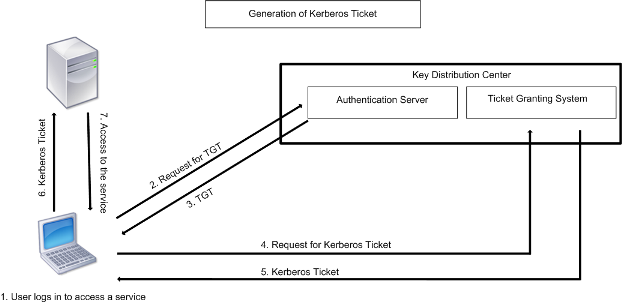Handling authentication, authorization and auditing with Kerberos/NTLM
Kerberos, a computer network authentication protocol, provides secure communication over the Internet. Designed primarily for client-server applications, it provides for mutual authentication by which the client and server can each ensure the other’s authenticity. Kerberos uses a trusted third party, referred to as Key Distribution Center (KDC). A KDC consists of an Authentication Server (AS), which authenticates a user, and a Ticket Granting Server (TGS).
Each entity on the network (client or server) has a secret key that is known only to itself and the KDC. The knowledge of this key implies authenticity of the entity. For communication between two entities on the network, the KDC generates a session key, referred to as the Kerberos ticket or service ticket. The client makes a request to the AS for credentials for a specific server. The client then receives a ticket, referred to as Ticket Granting Ticket (TGT). The client then contacts the TGS, using the TGT it received from the AS to prove its identity, and asks for a service. If the client is eligible for the service, the TGS issues a Kerberos ticket to the client. The client then contacts the server hosting the service (referred to as the service server), using the Kerberos ticket to prove that it is authorized to receive the service. The Kerberos ticket has a configurable lifetime. The client authenticates itself with the AS only once. If it contacts the physical server multiple times, it reuses the AS ticket.
The following figure shows the basic functioning of the Kerberos protocol.
Figure 1. Functioning of Kerberos

Kerberos authentication has the following advantages:
- Faster authentication. When a physical server gets a Kerberos ticket from a client, the server has enough information to authenticate the client directly. It does not have to contact a domain controller for client authentication, and therefore the authentication process is faster.
- Mutual authentication. When the KDC issues a Kerberos ticket to a client and the client uses the ticket to access a service, only authenticated servers can decrypt the Kerberos ticket. If the virtual server on the Citrix ADC appliance is able to decrypt the Kerberos ticket, you can conclude that both the virtual server and client are authenticated. Thus, the authentication of the server happens along with the authentication of the client.
- Single sign-on between Windows and other operating systems that support Kerberos.
Kerberos authentication may have the following disadvantages:
- Kerberos has strict time requirements; the clocks of the involved hosts must be synchronized with the Kerberos server clock to ensure that the authentication does not fail. You can mitigate this disadvantage by using the Network Time Protocol daemons to keep the host clocks synchronized. Kerberos tickets have an availability period, which you can configure.
- Kerberos needs the central server to be available continuously. When the Kerberos server is down, no one can log on. You can mitigate this risk by using multiple Kerberos servers and fallback authentication mechanisms.
- Because all the authentication is controlled by a centralized KDC, any compromise in this infrastructure, such as the user’s password for a local workstation being stolen, can allow an attacker to impersonate any user. You can mitigate this risk to some extent by using only a desktop machine or laptop that you trust, or by enforcing preauthentication by means of a hardware-token.
To use Kerberos authentication, you must configure it on the Citrix ADC appliance and on each client.
Optimizing Kerberos authentication on authentication, authorization, and auditing
The Citrix ADC appliance now optimizes and improves the system performance while Kerberos authentication. The authentication, authorization, and auditing daemon remembers the outstanding Kerberos request for the same user to avoid load on Key Distribution Center (KDC), which will avoid duplicate requests.